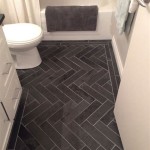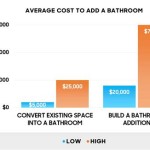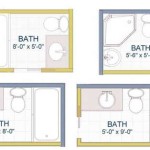What Is Standard Bathroom Vanity Height?
The bathroom vanity serves as a central functional and aesthetic element within a bathroom space. One of the most important factors to consider when selecting a bathroom vanity is its height. The height of the vanity directly impacts user comfort, accessibility, and overall bathroom usability. While personal preference plays a role, certain standard heights exist to ensure a generally ergonomic and accessible design. Deviation from these standards can lead to discomfort and accessibility issues for some users. Understanding the typical dimensions and factors influencing optimal vanity height is crucial for bathroom renovations and new construction projects.
The concept of "standard" can be misleading as it often represents the most common or traditionally accepted measurement. However, contemporary design trends and an increasing awareness of accessibility needs have broadened the range of acceptable and recommended vanity heights. This article will delve into the traditional standard vanity height, the advantages and disadvantages of alternative heights, and the key considerations for determining the optimal vanity height for a specific bathroom and its users.
Traditional Standard Height (30-32 Inches)
For many years, the standard height of a bathroom vanity has been between 30 and 32 inches from the floor to the top of the countertop. This measurement stemmed from average adult heights and the practicalities of plumbing configurations. This height typically accommodated individuals of average stature without requiring excessive bending or reaching, thus minimizing strain on the back and shoulders during washing and grooming activities.
The 30-32 inch height was often advantageous in smaller bathrooms where maximizing space was a priority. Lower vanities could allow for easier installation of mirrors and medicine cabinets above, while also contributing to a perception of greater space within the room. Plumbing lines were often more easily accommodated within the cabinet space below a lower vanity, which could simplify installation and reduce costs.
However, this traditional height can present challenges for taller individuals. Repeated bending and stooping to use a lower vanity can lead to back pain and discomfort. This is particularly problematic for those with pre-existing back issues or limited mobility. Furthermore, the lower height might be less accessible to people with certain disabilities or those who use mobility aids.
Comfort Height (34-36 Inches)
In recent years, a taller vanity height, often referred to as "comfort height," has gained significant popularity. Comfort height vanities typically range from 34 to 36 inches in height, offering a more ergonomic experience for a wider range of users. This increased height reduces the need for excessive bending, making it a more comfortable option for taller individuals and those with back problems.
The adoption of comfort height vanities aligns with the principles of universal design, which aims to create spaces and products that are accessible and usable by people of all ages and abilities. By raising the vanity height, designers and homeowners can create a more inclusive bathroom environment that caters to a broader spectrum of needs. This approach considers the diverse physical characteristics and capabilities of potential users.
While comfort height vanities offer several advantages, it's crucial to consider the potential drawbacks. In smaller bathrooms, a taller vanity might make the space feel more cramped. Careful consideration must be given to the placement of mirrors and medicine cabinets to ensure they remain at a comfortable and accessible height. Additionally, plumbing modifications may be required to accommodate the taller cabinet, potentially increasing installation costs.
Considerations for Determining Optimal Vanity Height
Selecting the optimal vanity height requires careful consideration of various factors, including the height of the primary users, the size of the bathroom, and the design style of the space. Prioritizing user comfort and accessibility is paramount in making an informed decision.
Height of Primary Users: The height of the individuals who will be using the bathroom most frequently is a primary consideration. If the bathroom is primarily used by taller individuals, a comfort height vanity is likely the best option. Conversely, if the bathroom is primarily used by shorter individuals or children, a shorter vanity or the inclusion of a step stool might be more appropriate. It’s also important to consider users with mobility issues or disabilities. Adjustable-height vanities or modifications to countertop heights may be required to ensure accessibility and ease of use.
Bathroom Size and Layout: The size and layout of the bathroom also play a crucial role in determining the optimal vanity height. In smaller bathrooms, a taller vanity might make the space feel cramped and overwhelming. Conversely, in larger bathrooms, a shorter vanity might appear disproportionately small. The overall design style of the bathroom should also be taken into account. Contemporary designs often favor taller vanities, while more traditional designs might incorporate shorter vanities.
Plumbing and Installation: Plumbing considerations are an important factor that can influence vanity height. Shifting plumbing lines to accommodate a taller or shorter vanity can add to the overall cost and complexity of the installation. It is important to consult with a qualified plumber to assess the feasibility of installing a vanity at the desired height and to determine any necessary plumbing modifications. Accessibility to shut-off valves and plumbing lines should also be considered when making this decision.
Countertop Material and Sink Type: The type of countertop material and sink selected can also impact the overall height of the vanity. Thicker countertop materials, such as granite or marble, may add to the overall height of the vanity, while thinner materials, such as laminate, may have a minimal impact. Similarly, the type of sink selected can also affect the overall height. Undermount sinks, for example, will typically result in a lower overall height compared to vessel sinks, which sit on top of the countertop. The combination of the chosen countertop material and sink should be considered when determining the cabinet height to achieve the desired overall vanity height.
Future Considerations: When selecting a vanity height, it is important to consider future needs and potential changes in the users of the bathroom. If there is a possibility that individuals with mobility issues or disabilities may use the bathroom in the future, it might be prudent to opt for a comfort height vanity or to incorporate features that enhance accessibility, such as grab bars or adjustable-height components. This proactive approach ensures that the bathroom will remain functional and accessible for a variety of users over time.
Ultimately, the optimal vanity height is a highly personal decision that should be based on a careful assessment of individual needs, bathroom characteristics, and design preferences. By considering these factors, homeowners can select a vanity height that promotes comfort, accessibility, and long-term satisfaction.

What Is The Standard Bathroom Vanity Height Size Guide

What Is The Standard Height Of A Bathroom Vanity

What Is The Standard Bathroom Vanity Height Size Guide

What Is The Standard Height Of A Bathroom Vanity

What Is The Standard Height Of A Bathroom Vanity Sizes Cabinets Vessel Sink

What Is The Standard Bathroom Sink Height

What Is The Standard Height Of A Bathroom Vanity 2024 Guide

What Is The Standard Height Of A Bathroom Vanity

48 Standard Bathroom Vanity Height Hp9n Sizes Cabinets Vessel Sink

What Is The Best Standard Height Of A Bathroom Vanity Maggiescarf







